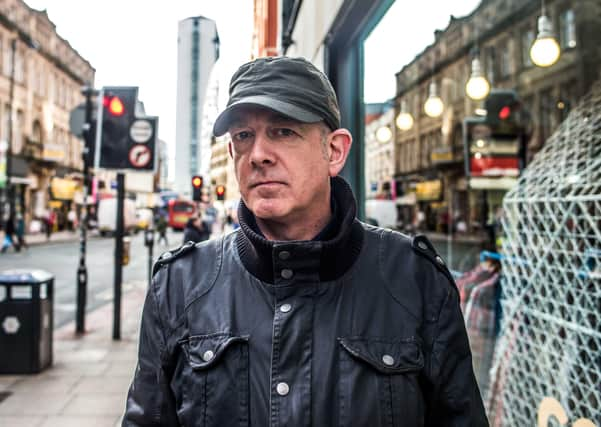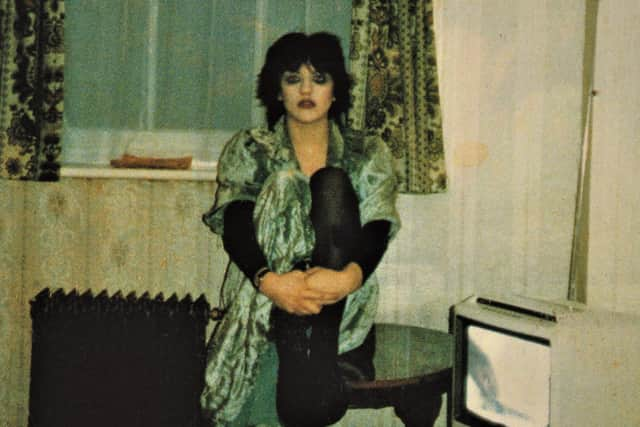Dave Haslam: ‘Courtney Love says she learned everything that she needed to know about being a rock star while in Liverpool’


His association with Manchester was forged 40 years ago when he moved to the city as an undergraduate, and he would go on to DJ hundreds of times at the Hacienda nightclub, write for the NME, found the record label Play Hard and later chronicle the city’s musical history in his book Manchester, England.
His new book, Searching For Love, however, is set 30 miles away, and traces the experiences of Courtney Love, then an aspiring 17-year-old musician, who spent five key months in her life in Liverpool in 1982. The chapter would inspire her later musical career with bands such as Faith No More and Hole, and as a solo artist.
Advertisement
Hide AdAdvertisement
Hide Ad“I’ve always been a big fan of the Liverpool music scene of that era,” says the author. “81-82 was when I first started going over there from Manchester. I got to know Pete Wylie and went to see the bands that were around. I found it very inspiring city.


“Then I became aware probably about ten ago...of her being in Liverpool and that was what first sparked my interest – the idea of that scene in Liverpool, that I remember being so exciting and so fertile, and Courtney as a 17-year-old engaging with that world.
“I became interested in understanding why it had such an impact that she ended up saying that it was one of the most important periods of her life and that she learned everything that she needed to know about being a rock star while in Liverpool for five months.”
Love’s Merseyside sojourn has been the subject of much mythologising; Haslam aimed to get as close to the truth as he could about the period. He says: “I thought if I investigated enough I’d be able to find the truth and be able to create a timeline of events of everything that happened, but I began to realise that I was never going to know the details.
Advertisement
Hide AdAdvertisement
Hide Ad“So I decided that I should put my cultural historian head to one side and instead in a way search for a different kind of truth. To try and find out something about the truth of human nature, and how on the one hand young people can be energised by an experience like that, at a stage when you’re particularly porous and impressionable in your formative years, and also the truth about how we remember our past. Not just Courtney, but all the people that met her.”
Haslam believes Love’s self-mythologising might in part have been a means of escape from a highly unconventional upbringing in the US. “I didn’t realise until I began to research the book just how chaotic and dysfunctional and alienating it must have been,” he says. “One of the things that struck me was how no one seemed to care about her, no one gave her a voice, no one listened to her.
“She was a young woman who was rejected in many ways by her mother [Linda Risi] and never had a stable relationship with her father [Hank Harrison, tour manager for the Grateful Dead]. She was moved to so many different places that she never had a network of friends until she was about 17 and going out in Portland, Oregon, meeting people in clubs and bars. They became, in a way, her substitute family, and music became, because of that, an even more important thing to her.
“I think she began to see rock ’n’ roll as a means of self-expression and a means of escape and being in Liverpool reinforced that for her.”
Advertisement
Hide AdAdvertisement
Hide AdPrior to Liverpool, Love had crossed the Atlantic in 1981 to stay with her biological father, who was then living in Dublin. Their relationship broke down and she began to frequent clubs and bars in Dublin. At a Teardrop Explodes gig she met the band, Haslam says. “Then a friend of hers called Robin [Barbur] came over and joined her and the two girls went to see Teardrop Explodes in London in February [1982]. They had been there for a couple of months and I think wanted to get out of London. They explained to [Teardrop Explodes singer] Julian [Cope] that they were a little bit at a loss what to do with time that they had in Britain, because their visas weren’t going to run out until July, and he said, ‘I have a room in a house in Liverpool which I’m not currently at. Go and knock on the door of No20 Devonshire Road and stay there’.”
At the house in Liverpool, Love encountered Paul Simpson of The Wild Swans and Pete de Freitas of Echo and the Bunnymen. The young women’s propensity for loudness led de Freitas to eventually ask them to leave. Haslam finds the story “a mixture of the mundane and the extraordinary”. “On the one hand you have this woman who was going to go on to become such an iconic figure and you have these characters who were on the front page of the NME often, but also both her and those characters were spending a lot of their time hanging around in the Armadillo tea rooms making a cup of Earl Grey tea and walking round with their big overcoats.
“Liverpool musicians weren’t stars and millionaires at that point and neither was she, and, like every multi-occupancy house, I think the dynamic between Courtney, Robin and the people they were sharing with was a bit strained. As Robin told me, they understood they were sometimes in the way of everybody, especially the boys who were in the bands, but they wanted to belong, I guess, and they wanted to be part of that circle.”
Although Julian Cope came to publicly disparage Love, another Liverpool contemporary, Pete Burns of Dead Or Alive, seemed to later come round respecting to her. Haslam says: “I think lots of people in Liverpool did like her, lots of people could see, as Pete Burns said, ‘the fire inside her’. I just don’t think a lot of people could cope with what she was like.
Advertisement
Hide AdAdvertisement
Hide Ad“Courtney says that in her life she has ‘before Liverpool’ and ‘after Liverpool’. As soon as she got back to America she formed a band, within 18 months she was lead singer with Faith No More and in the book I’m clear that Faith No More loved having her as a singer, they said she was challenging and fantastic onstage and had a great presence. The only reason why they didn’t keep her in Faith No More was because they thought their fanbase wouldn’t be able to deal with an honest, raw, challenging female singer, but she just blasted through all these obstacles. She’s had so many obstacles since and she’s blasted through them and survived.”
Searching For Love: Courtney Love in Liverpool, 1982 is the third in the Art Decades series of mini books by Haslam. The first, A Life in Thirty Five Boxes, examines why the DJ decided to sell his collection of 4,500 records after he separated from his wife. “I think divesting myself of all the records was instinctive,” he says. “If I had thought too hard about it I would probably never have allowed myself to do so.
“When I told my son I was selling my collection firstly he was disappointed because he saw them as his inheritance, but he also said to me, ‘Pick out the ones that mean most to you’ and I said to him, ‘If I do that I will keep them all because there’s a reason why I have all of them’. But then so many of our life decisions are like that anyway.
“I think being rational is over-rated; following your instinct and your heart is perfectly acceptable. There seemed to be a moment in my life when I had not stopped loving the records and I had certainly not stopped appreciating the music, but there was an emotional connection that I think I had lost with the vinyl and that enabled me to sell the bits of plastic. I knew that I still had the memories, and I could still listen to the music, it’s accessible online and elsewhere. I did not need the vinyl for DJing, but also looking back and thinking about how the instinctive decision came about, I do think I had reached a situation in my mid-50s where the perception maybe was that my golden age was the second half of the 80s. To me, I felt like so much of what I had done since then has been more important. I have done three or four dozen things in the last 10 years that I found as exciting as DJing at Spike Island.
Advertisement
Hide AdAdvertisement
Hide Ad“But at the same time I felt that past was weighing too heavily on me. Maybe it was mid-life but selling those records lightened my load in a Zen kind of way, but also it made me feel like my life was much more focused on the future, and that’s how I wanted it to be. I did not want to be a nostalgia monger milking the past. Selling up my records [to fellow DJ Seth Troxler] was a statement to myself and the world that I was looking forwards and not back.”
The second book in the series, We The Youth, focuses on the New York artist Keith Haring. Like Searching For Love, it starts in 1982. “I thought why don’t I begin the story of Haring at his height in 82 and then go backwards and forwards,” Haslam says. “One of the things I wanted to do with the series is there will be little themes and links between the books as they emerge. There are connections, I think, between Haring and Courtney Love books.”
Haring’s links to the music and nightclubbing scene in New York were strong. “That was the angle I wanted to explore,” Haslam says. “After writing Life After Dark: a history of British nightclubs and music venues and having lived in nightclubs and music venues all my life, I know what a catalyst for cultural activity they are, as well as everything else, they are places of entertainment and palaces of dreams and paradise garages. They are also places that can trigger all kinds of cultural activity, not just music.
“Knowing Keith Haring was into his music – everything from Devo and The B-52s right through to the kind of stuff that Larry Levan was playing at the Paradise Garage – and knowing that he went out a lot, that was my beginning point in trying to work out what were his inspirations musically and in terms of nightlife. But then I realised he anticipated a lot of nightlife as well. He put on exhibitions in New York in nightclubs, he painted murals in them, he performed poetry in nightclubs and he hung out with DJs, so it was not just a one-way relationship. He also contributed to that scene in New York in that era.”
Advertisement
Hide AdAdvertisement
Hide AdSearching For Love is priced £7 and available from www.confingopublishing.uk. Dave Haslam appears at a Leeds Literature Festival event at Hyde Park Book Club on Sunday March 8 (6pm), The Crescent, York on Monday March 16 and Magic Rock Brewery, Huddersfield on Sunday March 29. www.davehaslam.com
Comment Guidelines
National World encourages reader discussion on our stories. User feedback, insights and back-and-forth exchanges add a rich layer of context to reporting. Please review our Community Guidelines before commenting.